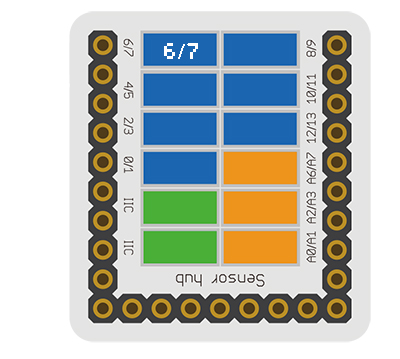Difference between revisions of "Sensor-Color LED Strip"
From Microduino Wiki
(Created page with "{{Language|Microduino-Color LED Strip }} {| style="width: 1000px;" | | 400px|thumb|right|mCookie-Hall The product number of mCookie S...") |
(→Introduction of Sensor Pin) |
||
| (8 intermediate revisions by one other user not shown) | |||
| Line 4: | Line 4: | ||
| | | | ||
[[File: Microduino-LEDStrip-rect-v1.jpg|400px|thumb|right|mCookie-Hall]] | [[File: Microduino-LEDStrip-rect-v1.jpg|400px|thumb|right|mCookie-Hall]] | ||
| − | The product number of | + | The product number of Sensor-Color LED Strip is: '''MSDL12''' |
| − | + | Sensor-Color LED Strip is full color LED strip, including 7 full color LED, which are cascadable. | |
| + | |||
| + | Only one I/O port can control the RGB color of each LED on the line. | ||
| + | |||
| + | The power supply supporting, it can support the cascade of as many as 1024 LEDs. | ||
==Introduction of Sensor Pin== | ==Introduction of Sensor Pin== | ||
| − | {{ | + | {{ST_Pinout |
| − | | | + | |st_name=Color LED Strip |
| − | | | + | |pin3=Digital Output (One-wire communication) |
| − | |||
}} | }} | ||
| − | |||
==Features== | ==Features== | ||
| − | * | + | *With flexible material which is easy to install on whatever shape of the surface. |
| − | * | + | *Flexible LED strip with 7 full color LEDs |
| − | + | *Adopts single serial cascade protocol which makes it cascadable | |
| + | *Only one I/O port can control the RGB color of each LED on the line | ||
| + | *Can achieve RGB 256-grade(1600W)toning, and the scanning frequency is no less than 400Hz/s | ||
==Specification== | ==Specification== | ||
| − | * | + | *Sensor voltage |
| − | ** | + | **5V working voltage |
| − | *Size of the sensor | + | *Size of the sensor |
| − | **Size of the board | + | **Size of the board: 127mm*11.43mm |
**1.27mm-spacing 4Pin interface connected with sensorhub | **1.27mm-spacing 4Pin interface connected with sensorhub | ||
| − | |||
*Function description | *Function description | ||
| − | **Adopts WS2812 | + | **Adopts WS2812 lampwick |
| − | **RGB of each | + | **7 full color LED flexible LED strip |
| − | **When the | + | **Adopts single serial cascade protocol, which makes it cascadable |
| − | + | **Only one I/O port can control the RGB color of each LED on the line. | |
| + | **Can achieve RGB 256-grade(1600W)toning, and the scanning frequency is no less than 400Hz/s | ||
| + | **When the updating speed is 30 frame/s, the cascade number is no less than 1024 | ||
*Connection | *Connection | ||
| − | **This sensor can be connected to the following interfaces of the core: '''D2~D13''' | + | **This sensor can be connected to the following interfaces of the core: '''D2~D13''', '''A0~A7''' |
| − | **Multiple sensors | + | **Multiple sensors cascade: connect the '''(<big>OUT</big>)''' of the former LED-Strip to the '''(<big>IN</big>)''' of the latter LED-Strip. |
==Document== | ==Document== | ||
| + | *Schematic diagram: '''[[File: Microduino-Color LED Strip.Zip]]''' | ||
| + | *Main chip: '''[[File: WS2812 datasheet.pdf]]''' | ||
| + | *You can use the sample programs in the following IDE libraries to do experiment on your own: [https://github.com/wasdpkj/Microduino-IDE-Support/tree/master/arduino-ide-Support/%5B1.6.x%5D-hardware(library)/hardware/Microduino/avr/libraries '''_07_Sensor_LED_WS2812'''] | ||
| − | |||
| − | |||
==Development== | ==Development== | ||
===Program Download=== | ===Program Download=== | ||
| − | *Download and unzip the program '''[[File: | + | *Download and unzip the program '''[[File:Sensor-Color LED Strip_Test.zip]]''' |
| − | |||
| − | === | + | ===Programming=== |
{{Upload | {{Upload | ||
|nameA=[[Microduino-Core]], [[Microduino-USBTTL]] | |nameA=[[Microduino-Core]], [[Microduino-USBTTL]] | ||
| Line 60: | Line 65: | ||
===Hardware Setup=== | ===Hardware Setup=== | ||
| − | *Referring to the following | + | *Referring to the following diagram, connect the '''IN''' port of Sensor-Color LED Strip to the digital port D6 of '''[[Microduino-Sensorhub]]'''. |
<br> | <br> | ||
[[file:Microduino-sensorhub_Color LED Strip.JPG|thumb|400px|left]] | [[file:Microduino-sensorhub_Color LED Strip.JPG|thumb|400px|left]] | ||
| Line 66: | Line 71: | ||
===Result=== | ===Result=== | ||
| − | *After download, observe the LED strip. | + | *After download, observe the LED strip. |
| − | *LED | + | *LED flashes in red and green successively with the interval of 1s. |
==Application== | ==Application== | ||
| − | *LED full | + | *LED full color light source |
| + | *LED full color entertaining diversion | ||
===Projects=== | ===Projects=== | ||
| − | + | * '''[[Bluetooth Lamp]]''' | |
* '''[[Rhythm Lamp]]''' | * '''[[Rhythm Lamp]]''' | ||
* '''[[Applause Enthusiasm Detection]]''' | * '''[[Applause Enthusiasm Detection]]''' | ||
| − | * '''[[ | + | * '''[[Colorful LED Light]]''' |
==Purchase== | ==Purchase== | ||
Latest revision as of 22:57, 30 March 2017
| Language: | English • 中文 |
|---|
|
The product number of Sensor-Color LED Strip is: MSDL12 Sensor-Color LED Strip is full color LED strip, including 7 full color LED, which are cascadable. Only one I/O port can control the RGB color of each LED on the line. The power supply supporting, it can support the cascade of as many as 1024 LEDs.
ContentsIntroduction of Sensor Pin
Features
Specification
Document
DevelopmentProgram Download
Programming
Hardware Setup
Result
Application
ProjectsPurchaseHistoryGallery
|


